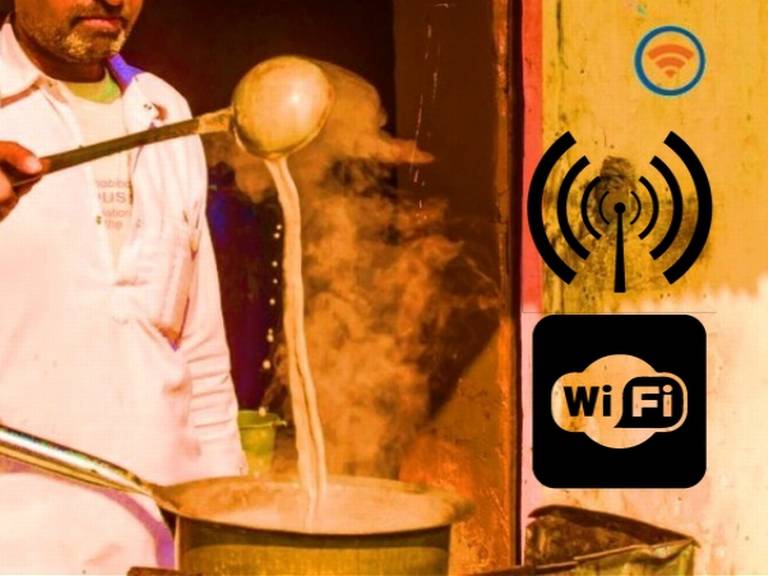
by Jinesh Parekh | Jul 30, 2015 | Uncategorized
मुंबई : येत्या काही दिवसातच मुंबईसह देशभरात चहाच्या गाड्यांवर चहासोबतच फुकटात वाय-फायही मिळणार आहे. ‘मुफ्त इंटरनेट’ ही संस्था 2016 पर्यंत देशभरातील चहाच्या टपऱ्यांवर सर्वच सार्वजनिक ठिकाणी ही सुविधा सुरू करणार आहे.
साधारणत: 500 रुपयात 50 जण 30 दिवसांसाठी एकदा इंटरनेट अॅक्सेस करू शकतात. म्हणजेच इंटरनेट अॅक्सेससाठी प्रत्येकी 10 रुपये मोजावे लागतात. पण ‘मुफ्त इंटरनेट’ने हे पैशाचं जाळं भेदून, सार्वजनिक ठिकाणी फुकटात इंटनेट अॅक्सेस पुरवण्याचा चंग बांधला आहे. चहाच्या टपऱ्या, कॅफेज, शाळा, रुग्णालये, रेल्वे स्टेशन्स यासारख्या सर्व सार्वजनिक ठिकाणी इंटरनेट फुकटात वापरता येईल.
“ना नोंदणी शुल्क, ना डेटा फी, MUFT WiFi hotspots हे फुकटात नेहमी इंटरनेट सेवा देईल. या सेवेचा लाभ घेण्यासाठी फक्त मुफ्त वाय-फाय अकाऊंट (MUFT WiFi account) क्रिएट करायचं आहे. ते झाल्यानंतर तुम्ही कुठेही, कधीही फुकटात इंटरनेट वापरू शकाल” असं ‘मुफ्त इंटरनेट’चे सहसंस्थापक विपुल पटेल यांनी सांगितलं.
‘मुफ्त इंटरनेट’ सध्या ही सेवा प्रत्यक्षात आणण्यासाठी जोमाने कामाला लागली आहे. सध्या 85 % भारत ऑफलाईन आहे. अनेक लोक याबाबत अद्याप जागृत नाहीत. मात्र फ्री इंटरनेमुळे जनतेला त्यांचा हक्क मिळेल आणि ते जगासोबत येतील, असं पटेल यांचं म्हणणं आहे.
‘मुफ्त इंटरनेट’ हे सरकारी अॅथोरिटी, उद्योग तज्ज्ञ आणि सिलीकॉन वॅली गुंतवणूकदारांसोबत मिळून ही सुविधा प्रत्यक्षात उतरवण्यासाठी काम करत आहे.
काही कॅफे, रेस्टॉरंट मोफत वाय- फाय पुरवत असल्यामुळे, त्यांचा बिझनेस वाढला आहे. मात्र आता ‘मुफ्त इंटरनेट’च्या माध्यमातून चहाच्या टपऱ्यांवरही मोफत इंटरनेट पुरवलं, तर लोक तिकडेही धाव घेतील. त्यामुळे त्यांचाही बिझनेस वाढू शकेल, असं नेहा रांभिया या माजी आयआयटीयन्सने म्हटलं आहे.
http://abpmajha.abplive.in/incoming/2015/01/18/article478861.ece/Chaiwalas-to-offer-free-WiFi-in-Mumbai
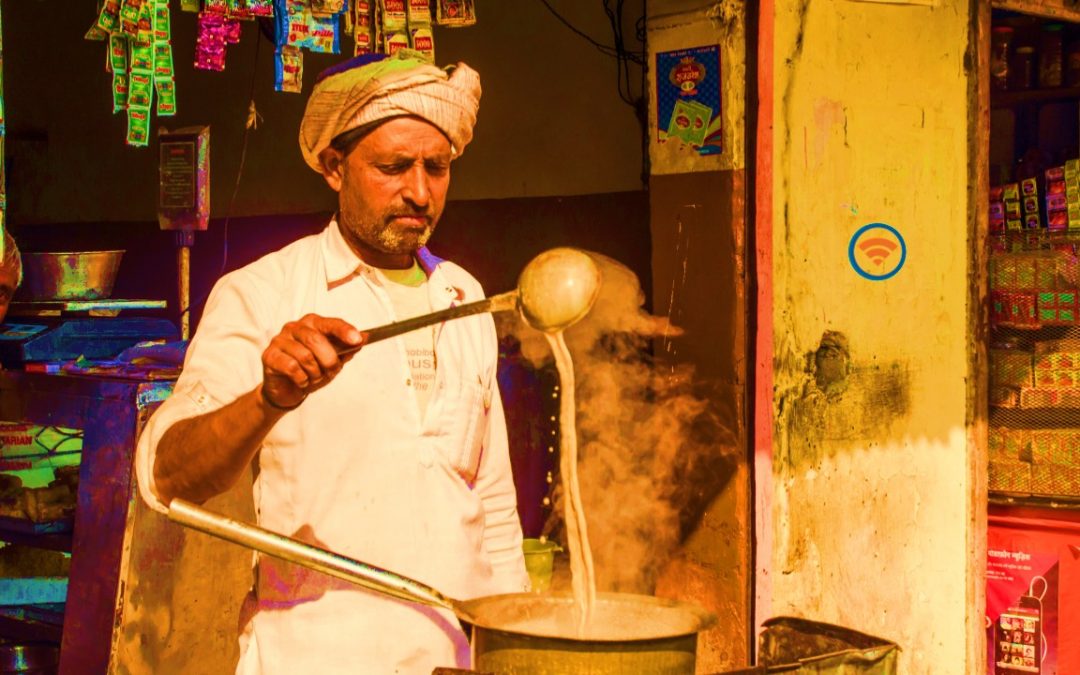
by Jinesh Parekh | Jul 15, 2015 | Uncategorized

PRESS RELEASE
Subject: Mumbai to get free WiFi spots soon!
By Jinesh Parekh
January 15, 2015
MUMBAI, IN – An organization called MUFT Internet, bulk internet service provider announced today that it has devised a technological system that will enable chai stalls in India with free WiFi access by 2016.
For a sum of INR 500 per month you could enable internet access for 50 people in India for 30 days. That’s an Internet bill of Rs.10 per person for an entire month. MUFT Internet plans to set up its free internet access points at chai stalls, cafes, schools, hospital clinics, train stops and all public areas.
“NO subscription fees. NO data fees. MUFT WiFi hotspots will ALWAYS be free. Just create a MUFT WiFi account and enjoy free internet everywhere! It should be that simple”
said Vipul Patel, co-founder of the Muft Internet project who plans to use a simplified network architecture and interaction design techniques to make it simple for users in India to access free internet.
Currently, 85% of India is still offline. 1 out of 1.3 billion Indians have never been online. The organization strongly believes that free internet should be considered as a human right and is working on ways to bridge the digital divide that includes providing internet for rural areas in India.
“Muft Internet has been working with government authorities, industry experts and Silicon Valley investors to make free internet access possible.”
– Mr Siddarth Bharwani, Director at Jetking Infotrain and member at Muft Internet.
The organization recently launched its first devices called the MUFT WiFi hotspots. These young scientists claim that with MUFT WiFi hotspots they will enable tea stalls to provide free internet access to its customers.
“Economic reforms begins with free internet access. Think of the impact on society with free information access!”
says Neha Rambhia (ex-IIT Bombay), a volunteer at Muft Internet.
Recent surveys shows cafes and restaurants that offer free WiFi enjoy more customers and footfalls than those who don’t. MUFT WiFi hotspots are helping small business owners improve their revenue and customer experience – by enabling their customers with free internet access.
MUFT WiFi hotspots will come in three monthly packages (hardware + software + service solutions) – Asha, Kiran and Pragati which will have a range of 25 m2, 50 m2 and 150 m2.
The pilot project begins with a small fast food joint called Mumbai Masala at Fort (Mumbai) and a hospital waiting room in Virar. The organization is reviewing applicants that can adopt these spots.
“I am excited about this idea. It’s refreshing and would love to see how my sales are improved after the free wifi service.” Said the very first owner of MUFT WiFi hotspot – Mr. Rajesh Shah (Owner, Mumbai Masala)
[youtube https://www.youtube.com/watch?v=obxv4NxU6v4]
Key facts about MUFT WiFi hotspots
- A free internet (WiFi) access point system that works with any ISP and can be used by EVERYONE for FREE INTERNET!
- MUFT WiFi hotspots uses a series of new and #opensource technologies in the field of network architecture, internet distributions, wireless networks and interaction design.
- MUFT WiFi hotspots will soon be present at train stations once the necessary permissions are obtained from the Railway ministry.
- Unlike most wireless network, MUFT WiFi hotspots manages the security of the entire network to prevent cyber attacks.
- The hardware is light weight, easy to install and is backed by powerful cloud technology that does not compromise on the security.
- The technology was created by researchers from over 8 universities – Tallinn University (Estonia), SciencePo University (France), Harvard Business School (USA), Singapore Management University are to name a few.
- The ultimate goal of this technology is to have “free WiFi cities” in India.
About Muft Internet
What started as a Human Computer Interaction and Participatory Design research project with an aim to bring more people from developing countries online is now turning into a revolutionary information access movement that will transform India into a digital society.
The word ‘Muft’ / (मुफ़्त) means ‘Free’ in Hindi. We believe that free Internet access is a human right.
NOTE: We are not internet service providers, we are enablers. We work with the ISPs, government authorities and advertisers/investors to enable places with free internet access.
Contact
To learn more about this please visit http://muftinternet.com/muftwifi/ or come over at:
THREE SPIN CREATIVE SOLUTION PVT LTD.
4TH FLR FEDERATION HOUSE
ANADILAL PODAR MARG
MUMBAI 400002
MAHARASHTRA, INDIA.
Phone: +91 22 2208 2800 | Email: [email protected]
[Tweet “BREAKING: Chaiwalas to offer free WiFi in Mumbai! #digitalindia #chai http://3sp.me/L1”]
ALSO, YOU CAN READ OUR NEW UPDATES
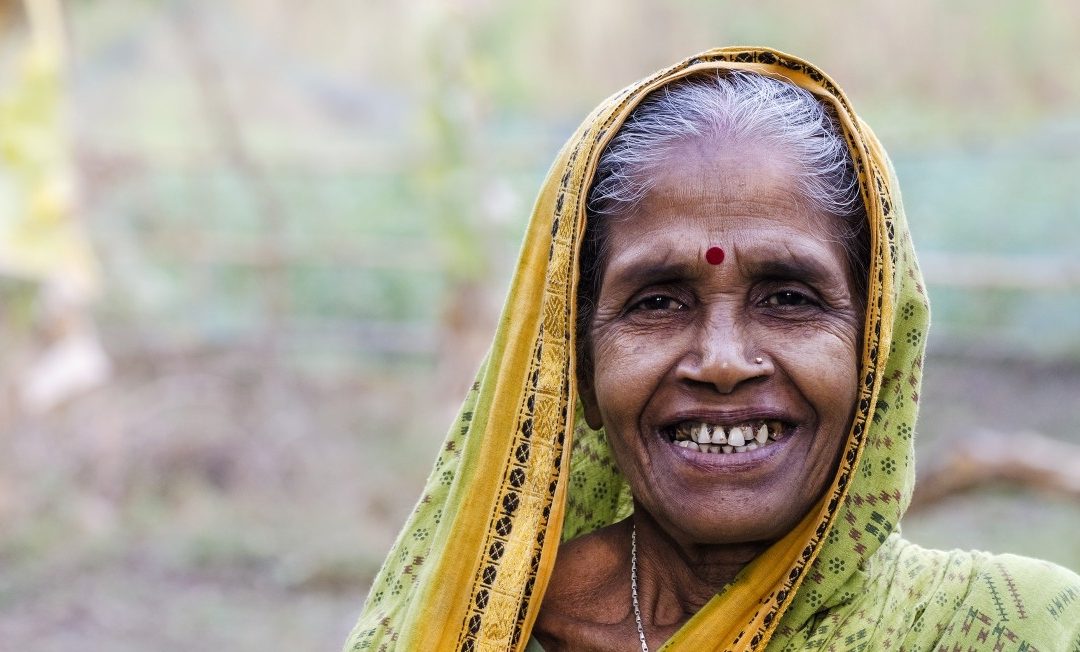
by Jinesh Parekh | Jul 13, 2015 | Uncategorized
The central government needs to partner communities at the grassroots level and integrate the country’s vernacular component to make the Digital India initiative a success, an expert said here Friday.
“Whatever money it (Centre) is spending on culture, heritage conservation and preservation etc., it is always a very centralized activity. ”It is very, very essential to partner local communities,” T. Vishnu Vardhan, programme director (Access to Knowledge), The Centre For Internet and Society, Bengaluru, told IANS here. Vardhan was attending the 10th anniversary celebrations of Athe Bengali Wikimedia community at the Jadavpur University here. Aiming to turn the country into a digitally empowered society and knowledge economy, the Narendra Modi government has envisaged the Rs.1 lakh crore Digital India project.
Global IT giant Microsoft and Google have offered to help with the programme. Vardhan said that while going forward with the project, the Centre must integrate the vernacular components. Else it will be restricted to Delhi and metro cities. Access to culture on digitised platforms should not be limited, he observed. ”The current government talks about Digital India. But when you talk about digital India, the key thing that one needs to take into consideration is not the India but the Bharat — the vernacular imagination of India, the regional imagination of India. ”Otherwise whatever grand plans they have will only be limited to Delhi and other metropolitan cities,” said Vardhan.
He suggested that the central government take note of examples like Wikipedia’s regional language domains to further the Digital India project. ”Wikipedia or wikisource where you put up the original prints source in digitised form and make it searchable… these are the examples that the government should look at because these are done with the help of local volunteers who come from the remotest regions,” said Vardhan.
via Government should partner local communities in ‘Digital India’: Expert | Latest Tech News, Video & Photo Reviews at BGR India.
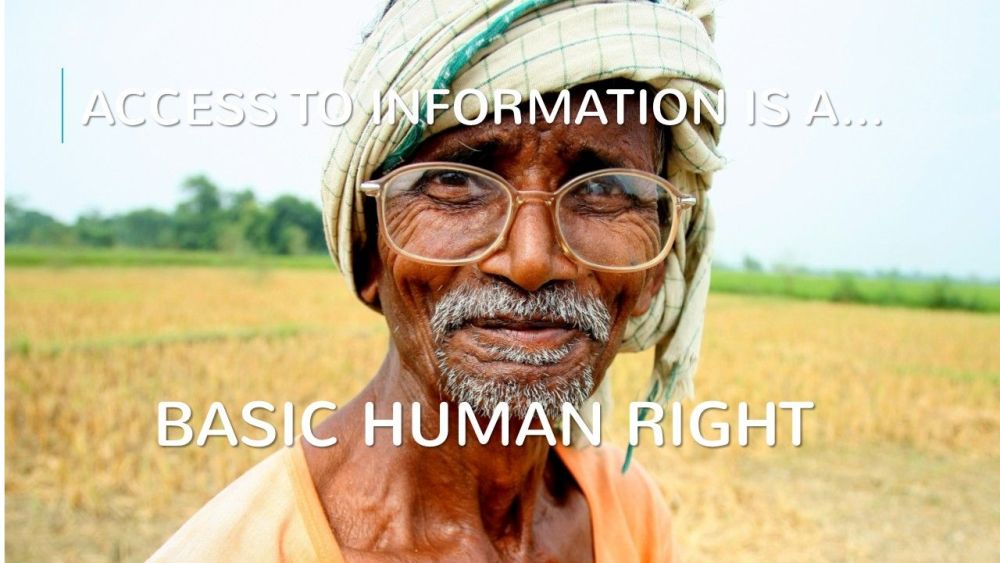
by Jinesh Parekh | Jul 10, 2015 | Uncategorized



Over the past few years and even today, it has been repeatedly pointed by researchers and NGOs through key World Development Indicators[1] that countries with higher internet penetration benefit with higher economic development, freer information and media communication, better educational and healthcare systems, improved democratic participation and overall Quality of Life[2] than the countries with low internet penetration.
The urgent need to bridge the digital divide has been recognized by he United Nations (Frank La Rue, 2011) and countries like Costa Rica (Human Rights Report: Costa Rica, 2011), Estonia (Facts about e-Estonia, 2014), Finland (Finland makes broadband a ‘legal right’, 2010), France (French Court Declares Internet Access ‘Basic Human Right’, 2009), Greece (Article 5, Constitution of Greece, 2008) and Spain (Sarah Morris, 2009); that have created frameworks and policies that consider Internet Access as a fundamental Human Right.
To understand how a society can completely transform itself by enabling internet access for its citizens, Estonia presents a great case study. Estonia, as a country with a population of 1.3 million, has one of the highest technology adoption rates with over 80% of citizens connected to the Internet as on 2013 (World Bank: Internet users (per 100 people), 2014). As Estonia declared Internet access as a human right in 2000 and took the necessary steps to increase Internet penetration with efforts like the Tiger Leap program[3] and EstWin[4]; Estonia enjoyed improved GDP and happiness index rankings. In less than 15 years, Estonia’s GDP grew by 4 times from 5.67 Billion USD in 2000 to 24.47 Billion USD in 2013. In 2013, over a fourth or 27% of services exported by Estonia were ICT based (Word Bank: GDP Ranking, 2014) amounting to 1.48 Billion USD (World Bank: ICT service exports (% of service exports, BoP), 2014). As of 2013, 99.6% of all banking transactions in Estonia were done online (Republic of Estonia – Information Systems Authority (RIA): Facts about e-Estonia, 2014) and in the 2011 elections 15.34% of eligible population voted online (Vabariigi Valimiskomisjon (VV): Statistics on eVoters, 2014).
Most Estonian (and world) researchers, academicians and general citizens believe that the Quality of Life in Estonia has improved as the country implemented and the necessarily ICT measures that transformed a crumpled post-soviet country into a highly advanced digital society.
Numerous studies have repeatedly shown how countries with higher adoption of Internet like Estonia have resulted in better educational systems, improved democracy and government services and higher economic development than countries that were late or non-adopters.
While users in some countries have been able to harness the potential of information technologies to thrive and become a major contender in today’s information economy, others have lagged behind as producers of low-value labor and products for wealthier nations. (Datta, 2011) Read more: http://muftinternet.com/openwiki/initial-literature-review/
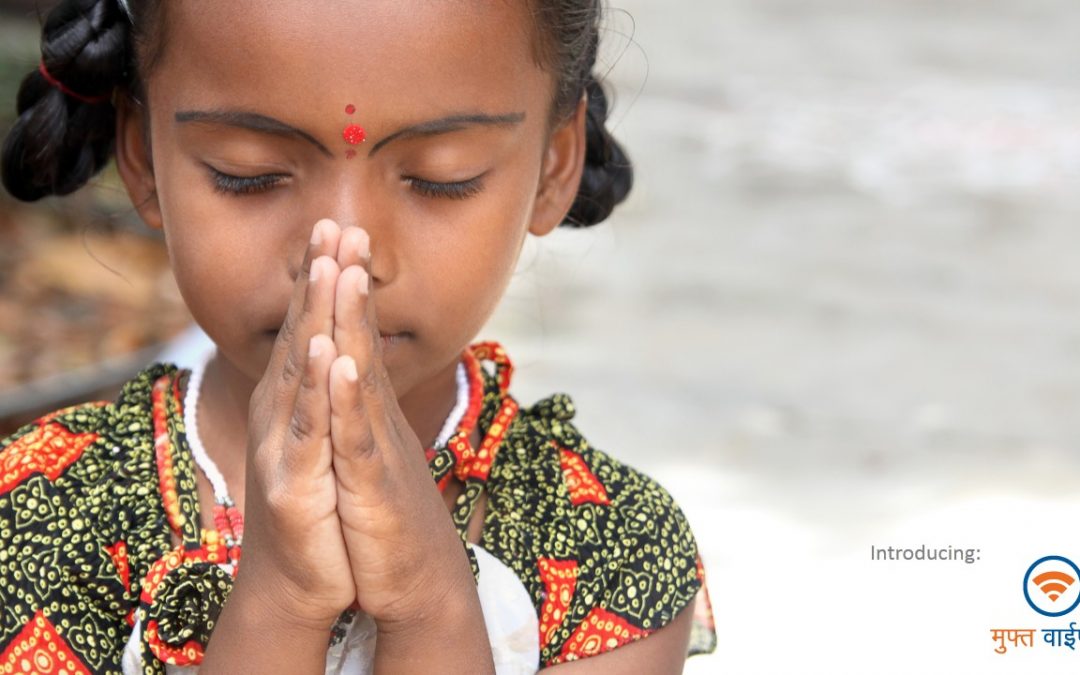
by Jinesh Parekh | Jul 10, 2015 | Uncategorized
ENABLING FREE INTERNET ACCESS
IN DEVELOPING COUNTRIES USING A
PARTICIPATORY DESIGN APPROACH
by
JINESH NAGIN PAREKH
Masters of Science in Human Computer Interaction
Institute of Informatics
Tallinn University, Estonia
2015
Supervised and approved by:
Professor David Lamas
Dr. Sonia Sousa
[youtube https://www.youtube.com/watch?v=fN2Q2DT8lMw]
Acknowledgements
I would like to thank the existing members of the HCID and ICTD community and their continued efforts to bridge the digital divide. This thesis would not be possible without the involvement of all the participant volunteers and their ideas, time and efforts.
A Special Thank You to the All the Key Enablers of the Design Project
For giving me crucial economic and financial insights with regards to ISP businesses in India and helping me create a business model for Muft WiFi.
Bharti Parekh (Business Modeling Expert and Chartered Account, ICAI India)
Nagin Parekh (Business Modeling Expert and Chartered Account, ICAI India)
Aditi Parekh (Consultant, Deloitte)
Hitesh Shah (Investment Expert, PPIC)
Ritesh Shah (Financial Analyst, ex-KMPG)
Neha Rambhia (Student, Harvard Business School)
Rajesh Shah (Entrepreneur, Mumbai Masala Café)
Siddharth Bharwani (COO, Jetking Infotrain)
Rashi Dhandia (MBA, Singapore Management University)
For giving me crucial insights on governmental efforts on bridging the digital divide, understanding government laws and regulations and national cyber security concerns.
Meenakshi Lekhi (Member of Parliament for Government of India)
Vijay Tribhuvan (Assistant commissioner, Mumbai Police)
Dilip Shah (Lawyer, Dilip Shah and Associates)
Akhil Gurwada (Lawyer, Mulla & Mulla & Craigie Blunt & Caroe)
For helping me understand wireless technologies, network architectures and developing the overall technical solutions required for this project.
Vipul Patel (Engineer, 3 Spin Creative Solutions)
Yatin Tribhuvan (Interaction Designer, Colorbud Studio)
Amit Goyal (Chief Engineer, Rirev)
Audrey Boullot (International Development (student), SciencePo Paris)
Mahendra Nagle (Freelance Network Architect)
Khwaja Umair (Human Computer Interaction (student), Tallinn University)
For giving me crucial insights on existing digital advertising and ad-market insights.
Preeti Vyas (Owner, VGC Interactive Designs)
Anushree Seth (Media Selling Expert, ex-Disney India)
Harshil Karia (Co-Founder, Foxymoron Digital Agency)
For their key volunteering efforts at different stages of the project:
Małgorzata Łuczkowska
Amey Tribhuvan
Mel Batson
Student volunteers from H.R College (RCHR Club)
Management Staff at Jetking Infotrain
Technical Staff at Realtel ISP
Technical Staff at Hathway ISP
Lastly, I would I like thank my supervisors Professor David Lamas and Dr. Sonia Sousa and my colleagues at Tallinn University’s Institute of Informatics for their constant support and guided expertise throughout this project.
Dedication
This thesis is dedicated to 60% of the human race whose creativity we miss out on every single day simply because they lack Internet access.
ABSTRACT
In the past couple of decades we have seen a sharp rise in Internet usage, data consumption and the overall number of Internet users. With the rise of broadband connectivity, mobile Internet, mobile applications and overall web utility through localized content and services; we have been able to observe many positive effects of Internet access. Many Human Computer Interaction and Development (HCID) and Information and Communication Technology and Development (ICTD) studies in this time have demonstrated how countries with higher Internet penetration and adoption enjoy better economic growth, improved educational systems, more democratic participation and overall enhancement in various Quality of Life (QOL) indicators.
As of 2014, the sad truth remains that over half of the human population is deprived of basic Internet access. Most of these people live in developing or poor countries. This reflects a deep gap between technology creators’ / designers’, policy makers’ and industry’s understanding/involvement of the end users. The problems lie beyond an individual’s conventional understanding like hardware availability, user literacy or network coverage.
Complex and intertwined sociotechnical roadblocks play a key role in curbing Internet penetration and adoption in many countries that face a huge digital divide. However, one common pattern can be spotted among such countries – ‘affordability’. Even with the sharp decline in prices of Internet enabled mobile devices and data plans over the past decade, quality Internet access still remains expensive or unaffordable to many.
The study was conducted in India with the goal of overcoming various legal, economic and technological barriers to ‘enable free Internet access’ for users. In this study, we try to address the problem of ‘affordability’ in Internet access for existing Internet users in India that own an Internet enabled mobile device but cannot afford to pay for mobile Internet packages. Using a Participatory Design approach and a Double Diamond design process, an economically sustainable and technologically scalable ‘free Wi-Fi Zone’ model was designed and prototyped in this study.
This research study aims to provide valuable insights to various research organizations, governmental bodies, Internet service providers, hardware/software companies and other agents working in the ICTD space and trying to bridge the digital divide.
ALSO, YOU CAN READ OUR NEW UPDATES









